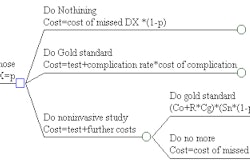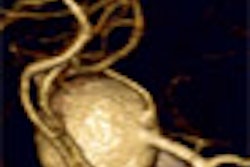(Ultrasound Review) Calcific shoulder tendinitis has been shown to respond to percutaneous needle aspiration of calcium deposits using ultrasound-guided aspiration. At the CHUM-Hôpital in Quebec, Canada, radiologists have further developed this technique using finer needles than previously described.
"Calcific tendinitis can lead to chronic debilitating shoulder pain associated with disability and thus can interfere with daily living activities," according to the authors. This study was published in the November issue of Radiology.
Just over 20 years ago, a similar technique was introduced using fluoroscopic guidance for needle placement. In 1995, an ultrasound-guided technique was described that used two 18-19 gauge needles to simultaneously fragment and aspirate the tendon calcifications. One of the needles was repeatedly (10-15 times) advanced into the calcification in order to cause separation.
"This in turn would allow sufficient disruption and localized bleeding, which facilitates absorption of the remainder of the material or its dispersion into the subacromial space," they said.
The authors were concerned that the large needles used in the technique described might cause damage to tendon fibers. They developed a similar single needle technique using 1.5-inch 22- or 25-gauge needle.
First, local anesthesia was injected and the needle was advanced into either the largest deposit of calcification or the area that best correlated with the patient’s symptoms. They evaluated the clinical response to treatment using a shoulder pain and disability index score.
"Thirty shoulders of 30 consecutive patients with chronic shoulder pain refractory to medical treatment were treated percutaneously by using a fine needle and ultrasound guidance," the authors wrote. The researchers determined that following treatment there was a statistically significant (27%) improvement in the shoulder pain and disability index total score. More specifically, the pain score improved to 30.5% and the disability score increased to 23.9%.
Follow-up ultrasound demonstrated reduced tendon calcification echogenicity in just under half the patients. There also was a significant decrease in size of deposits following treatment. The best response to treatment occurred in those patients that had successful aspiration of calcium deposits. On the basis of the results of this three and a half-year investigation, the group concluded that "this modified US-guided fine-needle technique for calcified tendinitis of the shoulder appears to be an effective therapy and was less aggressive than previously described percutaneous techniques," they said.
"Calcific shoulder tendinitis: treatment with modified US-guided fine-needle technique"R Aina et al
Dept of Radiology, CHUM-Hôpital Saint-Luc, Quebec, Canada
Radiology 2001(November); 221:455-461
By Ultrasound Review
January 8, 2002
Copyright © 2002 AuntMinnie.com



















